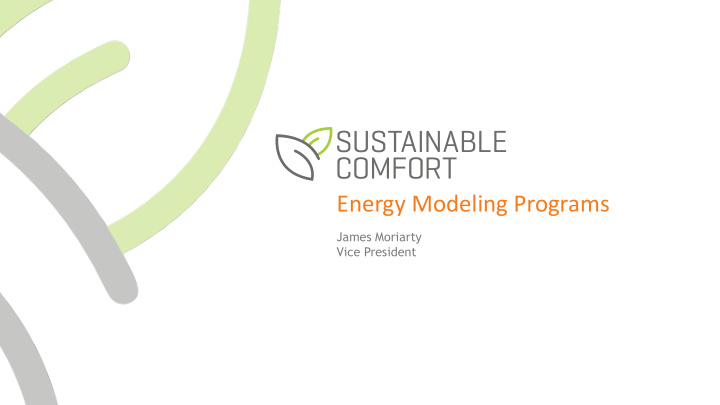



Energy Modeling Programs James Moriarty Vice President
Purpose • Basics of energy modeling simulations • Benefits and uses of various programs • Summary of available software tools • Considerations for Affordable Housing 2
What is Energy Modeling? Software simulation programs that take the building geometry, construction materials, insulation & mechanical systems, to combine with local weather conditions to develop custom estimates for energy use over time. Consider: Load Calculations consider only the worst case scenario • to determine maximum size of equipment Energy Modeling considers all interactions throughout • the entire year to generate hourly simulations of energy use Internal Document: Proprietary and Confidential 3 Aetna Foundation, Inc. Board of Directors Meeting – November 16, 2015 Board of Directors Meeting – November 2014
What is Energy Modeling? Various uses & applications for energy modeling Existing Buildings Retrofits Evaluate existing builds energy use to evaluate energy savings opportunities Brogan Manor New Construction Program Compliance Evaluate new buildings for program compliance such as Energy Star, LEED, or Passive House. Ebenezer Square – LEED Platinum Decision Making Assist in optimum decision making for energy efficiency for features such as insulation levels, mechanical systems, & building orientation. Tilley Lofts – LEED Platinum 4
USES: Quick decision making Simple Heat Loss SOFTWARE: Excel Energy improvement evaluations on existing USES: buildings Energy Auditing SOFTWARE: TREAT Programs Homes & Low Rise Multifamily USES: HERS Rating Energy Star Homes Certification REM/Rate SOFTWARE: Whole building energy simulations USES: ASHRAE 90.1 Appendix G Energy Star High Rise Certification eQuest, Trane TRACE, Carrier HAP SOFTWARE: Super low load buildings USES: Passive House Passive House Certification WUFI & PHPP SOFTWARE: 5
Simple Heat Loss Calculation Excel Benefits Quick to create, provides instant feedback • Available at the time of decision making • Limitations Based on individuals experience • Lack of detail can lead to over or underestimating savings • Rarely done at the time of greatest need • 6
Energy Auditing TREAT Benefits Calibrates to existing utility bills • Evaluate energy efficiency upgrades • Determine cost effective strategies • Limitations Not applicable to new construction • Not used in many certification programs • Time consuming to evaluate simple retrofit options • 7
HERS Rating REM/Rate Benefits Dedicated to homes & multifamily low rise • Used by most state utility companies to demonstrate energy savings • for new construction Recognized by Energy Star, LEED, Enterprise Green Communities • Robust network of HERS Raters, fees reasonable • Limitations Does not include common areas, simple single zone analysis • Does not provide realistic utility estimating, especially for • multifamily/senior Methods designed for single family homes • 8
ASHRAE 90.1 Appendix G eQuest, Trane TRACE, Carrier HAP Benefits Handles complex mechanical & building configurations • • More detailed inputs for nearly everything, lighting, fans, pumps, etc. Recognized by Energy Star, LEED, Enterprise Green Communities for • high rise projects (6+ stories, sometimes 4-5 stories) Limitations Costly to create, experience needed, usually created by a PE • Created late in the design process after many major decisions • already made Outputs not easy to understand, made for Engineers • 9
Passive House WUFI, PHPP Benefits Module for thermodynamic modeling of building assemblies (i.e. will • walls create moisture problems) Very detailed envelope inputs for super insulated buildings • Limitations Time consuming to create • Does not handle cooling loads well, separate engineering load • calculation needed for equipment sizing Typically single zone analysis for building envelope only • 10
Affordable Housing Considerations Utility costs savings are vitally important for low • income residents & long term building owners/operators Affordable Housing driven largely by compliance to • obtain funding Energy modeling and efficiency usually brought into • projects through programs (Utility Incentives, Energy Star, LEED, Passive House) Need better utility cost data to better inform utility • estimates for high performance buildings 11
Summary • Energy simulations are important for comparing energy efficiency options • Consider cost and time to create vs. information gained • Energy models used for program compliance don’t always provide realistic utility estimates • Avoid information overload, work with partners who can condense information to help make decisions 12
Questions? 13
Recommend
More recommend